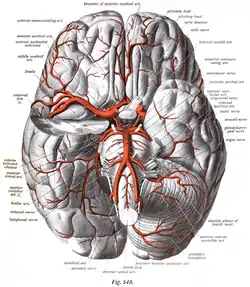Leptomeningeal collateral circulation
The leptomeningeal collateral circulation (also known as leptomeningeal anastomoses or pial collaterals) is a network of small blood vessels in the brain that connects branches of the middle, anterior and posterior cerebral arteries (MCA, ACA, and PCA),[1] with variation in its precise anatomy between individuals.[2] During a stroke, leptomeningeal collateral vessels allow limited blood flow when other, larger blood vessels provide inadequate blood supply to a part of the brain.[3]
| Leptomeningeal collateral circulation | |
|---|---|
 Arterial supply of the brain | |
| Details | |
| Location | around the brain |
| Function | small connections (anastamoses) between the areas supplied by the major arteries of the brain. |
| Anatomical terminology | |
Structure


Leptomeningeal collaterals lie within the leptomeninges, the two deep layers of the meninges called the pia mater and the arachnoid mater.[4] Their diameter has been measured at approximately 300 micrometers,[5] but there is variability between individuals in the size, quantity and location of these vessels, and between either hemisphere within the same subject.[6]
Inter-territorial end to end anastomoses exist between branches of the anterior cerebral artery and middle cerebral artery, the posterior cerebral artery and middle cerebral artery, the anterior cerebral artery and posterior cerebral artery, and the right and left anterior cerebral arteries.[7][8][9][10] Intra-territorial anastamoses connect adjacent arterial branches within the same arterial territory (between two branches of the same middle cerebral artery, for example).[5]
| Inter-territorial leptomeningeal anastamoses relative to branches of the middle cerebral artery[5] | |
|---|---|
| Supplying the Frontal Lobe | |
| Prefrontal arteries | No anastamoses observed |
| Orbito-frontal (lateral frontobasal) artery | Anterior and inferior frontal arteries (branches of the anterior cerebral artery) |
| Precentral (pre-rolandic) artery | Posterior inferior frontal artery (a branch of the anterior cerebral artery) |
| Central (rolandic) artery | Paracentral artery (a branch of the anterior cerebral artery) |
| Supplying the Parietal Lobe | |
| Anterior parietal artery | Precuneal artery (a branch of the anterior cerebral artery) |
| Posterior parietal artery | No anastamoses observed |
| Angular artery | Parieto-occipital artery (a branch of the posterior cerebral artery) |
| Temporo-occipital | No anastamoses observed |
| Supplying the Temporal Lobe | |
| Posterior temporal artery | No anastamoses observed |
| Middle temporal artery | No anastamoses observed |
| Anterior temporal artery | Anterior temporal artery (a branch of the posterior cerebral artery) |
| Temporopolar artery | No anastamoses observed |
Inter-territorial leptomeningeal anastamoses between the posterior cerebral artery and anterior cerebral artery have been observed between the parieto-occipital branch of the posterior cerebral artery, and the precuneal branch or the posterior pericallosal branch of the anterior cerebral artery.[1]
Inter-territorial leptomeningeal anastamoses between the right and left anterior cerebral arteries have been observed between the right and left pericallosal arteries and the right and left callosal marginal arteries. Anastamoses have also been observed between precuneal branches originating from the middle portion of the pericallosal artery, or from the posterior portion of the callosal marginal branch of one side joining the opposite paracentral branch.[1]
There is anatomical variation in collateral circulation from person to person, and as we age, collateral vessels decrease in diameter and number.[2]
Function
Leptomeningeal collateral vessels allow limited cerebral blood flow and brain tissue perfusion when the brain receives insufficient blood supply through an artery, via a series of anastomotic connections between cerebral arteries.[3]
Clinical significance
Stroke

During an ischaemic stroke, blood flow through a cerebral artery is compromised. This frequently causes substantial injury to the area of the brain supplied by the artery, but not all of this territory is necessarily affected. A post mortem study of middle cerebral artery strokes demonstrated that the area of brain injury was often smaller than the total area supplied by the middle cerebral artery. Leptomeningeal collateral vessels from the anterior cerebral artery and posterior cerebral artery appeared to allow for perfusion of some brain tissue to persist, partially compensating for the loss of the major vessel.[6] This compensatory effect is however usually inadequate to maintain a normal blood supply.[11]
Therapies that attempt to optimize leptomeningeal collateral circulation appear to improve outcomes following acute ischaemic stroke.[2]
MRI and CT brain imaging is used to determine the severity of a stroke, and help guide treatment. Fluid attenuated inversion recovery (FLAIR) vascular hyperintensity (FVH) is a radiographic marker seen on brain imaging in acute ischaemic stroke. FVH can be used as a proxy for slow leptomeningeal collateral blood flow, and may help reveal which areas of brain tissue are potentially salvageable.[12]
Alzheimer’s disease
The age-related changes that can be seen in leptomeningeal vessels over time appear to be accelerated by Alzheimer's disease, according to mouse models conducted in 2018.[13]
Intracranial haemorrhage
A 2016 study compared patients awaiting carotid artery stenting for unilateral atherosclerotic plaques. Those with leptomeningeal collaterals evident on cranial angiography had a higher incidence of intracranial haemorrhage (ICH) after stenting. The authors argued that the presence of such collaterals on imaging should be considered a risk factor for ICH in patients where carotid stenting is otherwise indicated.[14]
History

The term 'leptomeningeal' derives from the Greek word leptos (λεπτός) meaning thin, in reference to the appearance of the pia mater and arachnoid mater.
Descriptions of leptomeningeal collateral vessels are found in Thomas Willis’ Cerebri Anatome (1664).[15][16] German physician Otto Heubner first demonstrated their presence in his 1874 work Die luetische Erkrankung Der Hirnaterien.[17] He injected the middle cerebral artery, anterior cerebral artery and posterior cerebral artery in turn, in an attempt to establish the territories these arteries supply. Even when other anastomoses from the circle of Willis were blocked off, the whole cerebral arterial tree could be filled.[1] Later study in the 1950s and 60s by H.M. Vander Eecken and R.D. Adams provided a comprehensive review of the anatomy of the leptomeningeal collateral circulation.[6]
The concept of the ischaemic penumbra, where brain tissue shows capacity to recover if perfusion is quickly restored, was defined in 1981 by Astrup et al. Persistent blood flow through leptomeningeal vessels is a key part of this recovery.[18]
Other animals
Haemodynamic studies of leptomeningeal collaterals have been conducted in primates.[19] Leptomeningeal circulation has been observed in mice and rats during experiments to assess changes associated with disease and ageing in these vessels.[20]
References
- Brozici Mariana; van der Zwan Albert; Hillen Berend (2003-11-01). "Anatomy and Functionality of Leptomeningeal Anastomoses". Stroke. 34 (11): 2750–2762. doi:10.1161/01.STR.0000095791.85737.65. PMID 14576375.
- Winship, Ian R. (April 2015). "Cerebral collaterals and collateral therapeutics for acute ischemic stroke". Microcirculation. 22 (3): 228–236. doi:10.1111/micc.12177. ISSN 1549-8719. PMID 25351102. S2CID 206189480.
- Tariq N, Khatri R (October 2008). "Leptomeningeal collaterals in acute ischemic stroke". Journal of Vascular and Interventional Neurology. 1 (4): 91–5. PMC 3317324. PMID 22518231.
- Patel, Neel; Kirmi, Olga (2009). "Anatomy and imaging of the normal meninges". Seminars in Ultrasound, CT and MRI. 30 (6): 559–564. doi:10.1053/j.sult.2009.08.006. ISSN 0887-2171. PMID 20099639.
- Phan, Thanh G.; Hilton, James; Beare, Richard; Srikanth, Velandai; Sinnott, Matthew (2014-09-19). "Computer Modeling of Anterior Circulation Stroke: Proof of Concept in Cerebrovascular Occlusion". Frontiers in Neurology. 5: 176. doi:10.3389/fneur.2014.00176. ISSN 1664-2295. PMC 4168699. PMID 25285093.
- Vander Eecken HM, Adams RD (April 1953). "The anatomy and functional significance of the meningeal arterial anastomoses of the human brain". Journal of Neuropathology and Experimental Neurology. 12 (2): 132–57. doi:10.1097/00005072-195304000-00002. PMID 13053234. S2CID 33711931.
- Cipolla, Marilyn J. (2009). Anatomy and Ultrastructure. Morgan & Claypool Life Sciences.
- Türe, Uğur; Yaşargil, M. Gazi; Krisht, Ali F. (1996-12-01). "The Arteries of the Corpus Callosum: A Microsurgical Anatomic Study". Neurosurgery. 39 (6): 1075–1084. doi:10.1097/00006123-199612000-00001. ISSN 0148-396X. PMID 8938760.
- Kim, D.J.; Krings, T. (2011-09-01). "Whole-Brain Perfusion CT Patterns of Brain Arteriovenous Malformations: A Pilot Study in 18 Patients". American Journal of Neuroradiology. 32 (11): 2061–2066. doi:10.3174/ajnr.a2659. ISSN 0195-6108. PMC 7964413. PMID 21885720.
- Coyle, Peter (1994). "Collateral Pial Arteries". In Bevan, Rosemary D.; Bevan, John A. (eds.). The Human Brain Circulation. pp. 237–246. doi:10.1007/978-1-4612-0303-2_18. ISBN 9781461203032.
{{cite book}}:|work=ignored (help) - Derdeyn CP, Powers WJ, Grubb RL (September 1998). "Hemodynamic effects of middle cerebral artery stenosis and occlusion" (PDF). AJNR. American Journal of Neuroradiology. 19 (8): 1463–9. PMC 8338700. PMID 9763379.
- Liu, Dezhi; Scalzo, Fabien; Rao, Neal M; Hinman, Jason D.; Kim, Doojin; Ali, Latisha K; Saver, Jeffrey L.; Sun, Wen; Dai, Qiliang (2016). "FLAIR Vascular Hyperintensity Topography, Novel Imaging Marker for Revascularization in Middle Cerebral Artery Occlusion". Stroke: A Journal of Cerebral Circulation. 47 (11): 2763–2769. doi:10.1161/STROKEAHA.116.013953. ISSN 0039-2499. PMC 5079823. PMID 27659851.
- Zhang, Hua; Jin, Bo; Faber, James E. (2018-12-05). "Mouse models of Alzheimer's disease cause rarefaction of pial collaterals and increased severity of ischemic stroke". Angiogenesis. 22 (2): 263–279. doi:10.1007/s10456-018-9655-0. ISSN 1573-7209. PMC 6475514. PMID 30519973.
- Lee, Kang Ji; Kwak, Hyo Sung; Chung, Gyung Ho; Song, Ji Soo; Hwang, Seung Bae (May 2016). "Leptomeningeal collateral vessels are a major risk factor for intracranial hemorrhage after carotid stenting in patients with carotid atherosclerotic plaque". Journal of NeuroInterventional Surgery. 8 (5): 512–516. doi:10.1136/neurintsurg-2014-011634. ISSN 1759-8486. PMID 25841168. S2CID 24415856.
- Lega, Bradley C. (2006). "An Essay Concerning Human Understanding: How the Cerebri Anatome of Thomas Willis Influenced John Locke". Neurosurgery. 58 (3): 567–576. doi:10.1227/01.neu.0000197489.17675.c6. ISSN 0148-396X. PMID 16528199.
- Willis, Thomas (1664). Cerebri anatome : cui accessit Nervorum descriptio et usus /. Londini: Typis Tho. Roycroft, impensis Jo. Martyn & Ja. Allestry ...
- "Die luetische Erkrankung der Hirnarterien". Wellcome Library. Retrieved 2019-03-10.
- Paciaroni, Maurizio; Caso, Valeria; Agnelli, Giancarlo (2009). "The concept of ischemic penumbra in acute stroke and therapeutic opportunities". European Neurology. 61 (6): 321–330. doi:10.1159/000210544. ISSN 1421-9913. PMID 19365124.
- Symon, L. (1968). "Haemodynamic studies of the leptomeningeal circulation in primates". Proceedings of the Royal Society of Medicine. 61 (6): 610–612. doi:10.1177/003591576806100629. ISSN 0035-9157. PMC 1902586. PMID 4969977.
- Li, Zhaojin; Tremble, Sarah M.; Cipolla, Marilyn J. (2018-12-01). "Implications for understanding ischemic stroke as a sexually dimorphic disease: the role of pial collateral circulations". American Journal of Physiology. Heart and Circulatory Physiology. 315 (6): H1703–H1712. doi:10.1152/ajpheart.00402.2018. ISSN 1522-1539. PMC 6336971. PMID 30239233.